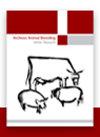The relationships between κ-casein (CSN3) gene polymorphism and some performance traits in Simmental cattle
IF 1.6
3区 农林科学
Q2 AGRICULTURE, DAIRY & ANIMAL SCIENCE
引用次数: 3
Abstract
Abstract In this study we aim to examine genotypic structures in terms of the κ -casein (CSN3) gene locus in 70 head of Simmental cattle raised in a private enterprise in Erzurum to determine the distribution of genotypes and allele frequencies in cattle in terms of related genes and to correlate the determined genotypes with some performance characteristics. CSN3/HinfI gene polymorphisms were identified in DNA isolated from blood samples taken from Simmental cattle used in the study using the polymerase chain reaction–restriction fragment length polymorphism (PCR-RFLP) method. The frequency of the AA, AB, and BB genotype of the CSN3 gene in the population was 57.14 %, 32.86 %, and 10.00 %, respectively; the frequency of the A allele was 0.74; and the frequency of the B allele was 0.26. The mean value for the AA, AB, and BB genotypes was 5151 ± 308.6, 5805 ± 370.3, and 5772 ± 547.3 kg for real milk yield, respectively; 5313 ± 233.9, 5784 ± 280.7, and 6458 ± 414.8 kg in 305 d for milk yield; 17.9 ± 0.75, 18.6 ± 0.89, and 19.6 ± 1.32 kg for daily milk yield; and 294 ± 13.7, 316 ± 16.5, and 294 ± 24.4 d during the lactation period. The distribution of the CSN3 gene locus in the studied population is in genetic equilibrium according to the Hardy–Weinberg principle. The genotype and allele frequencies determined in terms of CSN3 gene polymorphism can be considered sufficient to reveal the genotype diversity of the breed, and it was determined that the relationship of CSN3 genotypes was only significant with 305 d milk yield ( P<0.05 ) in terms of the association between CSN3 genotypes and some performance traits. It has been concluded that animals with the CSN3 BB genotype have an economic advantage within the herd and that CSN3 can be used for marker-assisted selection (MAS) in this regard.西蒙塔尔牛κ-酪蛋白(CSN3)基因多态性与部分生产性能的关系
摘要本研究旨在检测70头埃尔祖鲁姆一家私营企业饲养的西门塔尔牛的κ -酪蛋白(CSN3)基因型结构,以确定相关基因在牛中的基因型分布和等位基因频率,并将所确定的基因型与某些生产性能特征联系起来。采用聚合酶链反应-限制性片段长度多态性(PCR-RFLP)方法对西门塔尔牛血液样本分离的DNA进行了CSN3/ hini基因多态性鉴定。CSN3基因AA型、AB型和BB型在人群中的出现频率分别为57.14 %、32.86 %和10.00 %;A等位基因频率为0.74;B等位基因的频率为0.26。AA、AB、BB基因型的实际产奶量平均值分别为5151 ± 308.6、5805 ± 370.3、5772 ± 547.3 kg;305 d产奶量为5313 ± 233.9、5784 ± 280.7、6458 ± 414.8 kg;日产奶量分别为17.9 ± 0.75、18.6 ± 0.89、19.6 ± 1.32 kg;哺乳期为294次 ± 13.7,316次 ± 16.5,294次 ± 24.4 d。根据Hardy-Weinberg原理,CSN3基因位点在研究群体中的分布处于遗传平衡状态。根据CSN3基因多态性确定的基因型和等位基因频率可以认为足以揭示该品种的基因型多样性,在CSN3基因型与部分生产性能性状的相关性方面,CSN3基因型仅与305 d产奶量存在显著关系(P<0.05)。综上所述,CSN3 BB基因型动物在畜群中具有经济优势,在这方面CSN3可以用于标记辅助选择(MAS)。
本文章由计算机程序翻译,如有差异,请以英文原文为准。
求助全文
约1分钟内获得全文
求助全文
来源期刊

Archiv Fur Tierzucht-Archives of Animal Breeding
农林科学-奶制品与动物科学
CiteScore
3.20
自引率
0.00%
发文量
41
审稿时长
18-36 weeks
期刊介绍:
Archives Animal Breeding is an open-access journal publishing original research papers, short communications, brief reports, and reviews by international researchers on scientific progress in farm-animal biology. The journal includes publications in quantitative and molecular genetics, genetic diversity, animal husbandry and welfare, physiology, and reproduction of livestock. It addresses researchers, teachers, stakeholders of academic and educational institutions, as well as industrial and governmental organizations in the field of animal production.
 求助内容:
求助内容: 应助结果提醒方式:
应助结果提醒方式:


